Design of Oil Mist and Volatile-Organic-Compound Treatment Equipment in the Manufacturing Plant
Abstract
1. Introduction
2. Materials and Methods
2.1. Design Scheme and Working Principle
2.1.1. Electrostatic Adsorption of Oil Mist
2.1.2. Activated-Carbon Adsorption
2.1.3. Catalytic Combustion
2.2. Critical Equipment Design
2.2.1. Cellular Electrostatic Tower
2.2.2. Dry Filter Box
2.2.3. Activated-Carbon Box
2.2.4. Catalytic Combustion Chamber Design
- (1)
- Catalyst selection
- (2)
- Heat-exchange unit
- (3)
- Heating unit design
2.3. Control System Design
Main System Control Flow
2.4. System Temperature Control Design
2.4.1. Fuzzy PID Controller Design
2.4.2. Mathematical Model of Temperature
2.4.3. Traditional Control Algorithm
2.4.4. Fuzzy PID Control Algorithm
3. Results
3.1. Testing Equipment
3.2. Test Standard
3.3. Test Run Results
3.3.1. System Operation Test
3.3.2. System Operating Costs
3.3.3. VOC Treatment Effect
4. Discussion
4.1. Analysis of Processing Capacity and Processing Efficiency
4.2. Innovation and Advantage
4.3. Environmentally Friendly Materials
4.4. Application Prospects and Potential Challenges
- (1)
- Optimize the control system of the equipment and integrate the management of the equipment with the Internet of Things to facilitate personnel to view it via the Internet of Things at any time.
- (2)
- Develop an APP mini-program to transfer the alarm records of the equipment to the mobile phones of relevant personnel in real time through the mini-program, enabling the prompt discovery and handling of equipment failures and ensuring the normal and stable operation of the equipment.
4.5. Balance and Traceability of Pollutants
5. Conclusions
- (1)
- The coupled treatment of oil-mist VOCs generated during the production process of the enterprise was successfully achieved. The entire process not only retrieved and eliminated the oil mist but also executed adsorption and desorption as well as catalytic combustion treatment of VOCs. The gas at the inlet and outlet of the equipment was collected for detection, and the data, such as gas mass concentration, rate, and air volume, were analyzed and computed. The results manifested that the VOC emission mass concentration at the equipment outlet was 6.36 mg·m−3, and the average removal efficiency of the equipment treatment reached 93.99%, which was significantly higher than the 70% standard stipulated in China.
- (2)
- In the equipment control system, the fuzzy PID control algorithm was utilized to achieve precise temperature control. This algorithm exhibits certain advantages in terms of control accuracy, response time, and dynamic response. The temperature overshoot was reduced by 85%, which could curtail energy consumption and actively comply with China’s energy conservation and emission-reduction policies.
Author Contributions
Funding
Data Availability Statement
Acknowledgments
Conflicts of Interest
References
- Wu, X.Q.; Han, R.; Liu, Q.L.; Yun, S.; Lu, S.C.; Yang, L.Z.; Song, C.F.; Ji, N.; Ma, D.G.; Lu, X.B. A review of confined-structure catalysts in the catalytic oxidation of VOCs: Synthesis, characterization, and applications. Catal. Sci. Technol. 2021, 11, 5374–5387. [Google Scholar] [CrossRef]
- Buss, W.; Mašek, O.; Graham, M.; Wüst, D. Inherent organic compounds in biochar–their content, composition and potential toxic effects. J. Environ. Manag. 2015, 156, 150–157. [Google Scholar] [CrossRef] [PubMed]
- Niu, H.; Mo, Z.W.; Shao, M.; Lu, S.H.; Xie, S.D. Screening the emission sources of volatile organic compounds (VOCs) in China by multi-effects evaluation. Front. Environ. Sci. Eng. 2016, 10, 25–35. [Google Scholar] [CrossRef]
- Hussain, M.S.; Gupta, G.; Mishra, R.; Patel, N.; Gupta, S.; Alzarea, S.I.; Kazmi, I.; Kumbhar, P.; Disouza, J.; Dureja, H.; et al. Unlocking the secrets: Volatile organic compounds (VOCs) and their devastating effects on lung cancer. Pathol. Res. Pract. 2024, 255, 155157. [Google Scholar] [CrossRef]
- Zhong, M.F.; Li, Z.B.; Huang, H.M.; Ye, D.Q. Research on the emission characteristics and reduction potential of volatile organic compounds from industrial sources under the background of “Carbon Peak and Carbon Neutrality. Acta Sci. Circumst. 2022, 42, 12–25. [Google Scholar] [CrossRef]
- Mcdonald, B.C.; Gouw, J.A.D.; Gilman, J.B.; Jathar, S.H.; Akherati, A.; Cappa, C.D.; Jimenez, J.L.; Lee-taylor, J.; Hayes, P.L.; McKeen, S.A. Volatile chemical products emerging as largest petrochemical source of urban organic emissions. Science 2018, 359, 760–764. [Google Scholar] [CrossRef]
- The Central People’s Government of the People’s Republic of China, Further Lay The heavy Weather to Eliminate Pollution, Ozone Pollution Prevention and Diesel Cargo Vehicle Pollution Control Battle Action. Available online: https://www.gov.cn/zhengce/zhengceku/2022-11/17/content_5727605.htm (accessed on 10 November 2022).
- Ministry of Ecology and Environment of the People’s Republic of China, Ecological Environment in February Held a Regular Press Conference. Available online: https://www.mee.gov.cn/xxgk2018/xxgk/xxgk15/202102/t20210225_822424.html (accessed on 25 February 2021).
- Simon, H.; Hogrefe, C.; Whitehill, A.; Foley, K.M.; Liljegren, J.; Possiel, N.; Wells, B.; Henderson, B.H.; Valin, L.C.; Tonnesen, G.; et al. Revisiting day-of-week ozone patterns in an era of evolving US air quality. Atmos. Chem. Phys. 2024, 24, 1855–1871. [Google Scholar] [CrossRef]
- Liu, F.; Liu, W.; Long, Z.W.; Zhang, T.F. Evolution of particle size distribution and water content for oily particles in machining workshops. J. Build. 2024, 84, 108542. [Google Scholar] [CrossRef]
- Pui, W.K.; Yusoff, R.; Aroua, M.K. A review on activated carbon adsorption for volatile organic compounds (VOCs). Rev. Chem. Eng. 2019, 35, 649–668. [Google Scholar] [CrossRef]
- Li, K.; Luo, X. Research Progress on catalytic combustion of volatile organic compounds in industrial waste gas. Catalysts 2023, 13, 268. [Google Scholar] [CrossRef]
- Qu, M.M.; Cheng, Z.W.; Sun, Z.R.; Chen, D.Z.; Yu, J.M.; Chen, J.M. Non-thermal plasma coupled with catalysis for VOCs abatement: A review. Process Saf. Environ. Prot. 2021, 153, 139–158. [Google Scholar] [CrossRef]
- Tian, J.; Shi, Z.C.; Wan, Y.M.; He, H.X.; Li, T.; Ren, B.Z. Research progress of terminal treatment technology of volatile organic compounds. Appl. Chem. Ind. 2019, 48, 1433–1439. [Google Scholar] [CrossRef]
- Ozturk, B.; Kuru, C.; Aykac, H.; Kaya, S. VOC separation using immobilized liquid membranes impregnated with oils. Sep. Purif. Technol. 2015, 153, 1–6. [Google Scholar] [CrossRef]
- Zhang, X.L.; Ju, F.; Luan, H.; Xiu, G.L.; Ling, H. Dynamic adsorption behavior of light hydrocarbon VOCs on activated carbon. Environ. Prot. Chem. Ind. 2018, 38, 437–444. [Google Scholar]
- Mista, W.; Kacprzyk, R. Decomposition of toluene using non-thermal plasma reactor at room temperature. Catal. Today 2008, 137, 345–349. [Google Scholar] [CrossRef]
- Li, X.; Ma, J.; Ling, X. Design and dynamic behavior investigation of a novel VOC recovery system based on a deep condensation process. Cryogenics 2020, 107, 103060. [Google Scholar] [CrossRef]
- Yang, C.; Miao, G.; Pi, Y.H.; Xia, Q.B.; Wu, J.L.; Li, Z.; Xiao, J. Abatement of various types of VOCs by adsorption/catalytic oxidation: A review. Chem. Eng. J. 2019, 370, 1128–1153. [Google Scholar] [CrossRef]
- Zhao, H.M.; He, S.; Du, W.W.; Kong, X.Q.; Liu, Q.K. Common problems and countermeasures of VOCs exhaust gas terminal treatment measures in equipment manufacturing industry clusters. Mod. Chem. Ind. 2024, 44, 1–5. [Google Scholar]
- Liu, G. Practical Application of Activated Carbon Adsorption Concentration + Catalytic Combustion Technology. Chem. Eng. Manag. 2022, 2022, 99–101+125. [Google Scholar] [CrossRef]
- Ke, Y.T. Characteristics and control technology of volatile organic compounds emission from solvent use sources. South China Univ. Technol. 2020, 6, 9. [Google Scholar] [CrossRef]
- Zhou, L.J.; Xu, Z.Y. Ultralight, highly compressible, hydrophobic and anisotropic lamellar carbon aerogels from graphene/polyvinyl alcohol/cellulose nanofiber aerogel as oil removing absorbents. J. Hazard. 2020, 388, 121804. [Google Scholar] [CrossRef] [PubMed]
- Wu, H.; Yang, C.Z.; Dong, L.; Zhao, J. Discharge Characteristic of RS Barbed Electrodes in Wire-plate Electrostatic Precipitator in Air Environment. Energy Sci. Technol. 2020, 18, 42–48. [Google Scholar]
- Kujawa, J.; Zieba, M.; Zieba, W.; Al-gharabli, S.; Kujawski, W.; Terzyk, A.P. Hedgehog-like structure, PVDF-carbon nanohorn hybrid membranes for improved removal of VOCs from water. Chem. Eng. J. 2022, 438, 135574. [Google Scholar] [CrossRef]
- Li, D.; Chen, X.; Shu, C.Z.; Huang, Y.; Zhang, P.C.; Xiao, B.B.; Zhou, D. Ca-decorated MoBOH as a promising adsorbent for CH2O, C6H6, C3H6O, and C2HCl3 removal at room temperature: A first principle study. Appl. Surf. Sci. 2021, 563, 150233. [Google Scholar] [CrossRef]
- Wu, L.; Zhu, Y.; Yuan, J.; Guo, X.Z.; Zhang, Q.F. Advances in adsorption, absorption, and catalytic materials for VOCs generated in typical industries. Energies 2024, 17, 1861. [Google Scholar] [CrossRef]
- Liu, H.J.; Xu, B.W.; Wei, K.Y.; Yu, Y.S.; Long, C. Adsorption of low-concentration VOCs on various adsorbents: Correlating partition coefficient with surface energy of adsorbent. Sci. Total Environ. 2020, 733, 139376. [Google Scholar] [CrossRef]
- He, C.; Cheng, J.; Zhang, X.; Douthwaite, M.; Pattisson, S.; Hao, Z.P. Recent advances in the catalytic oxidation of volatile organic compounds: A review based on pollutant sorts and sources. Chem. Rev. 2019, 119, 4471–4568. [Google Scholar] [CrossRef]
- Chen, Z.; Li, J.; Cheng, Z.; Zuo, S.F. Well-defined and highly stable AlNi composite pillared clay supported PdOx nanocrystal catalysts for catalytic combustion of benzene. Appl. Clay Sci. 2018, 163, 227–234. [Google Scholar] [CrossRef]
- Kim, H.S.; Kim, H.J.; Kim, J.H.; Kim, J.H.; Kang, S.H.; Ryu, J.H.; Park, N.K.; Yun, D.S.; Bae, J.W. Noble-metal-based catalytic oxidation technology trends for volatile organic compound (VOC) removal. Catalysts 2022, 12, 63. [Google Scholar] [CrossRef]
- Kim, J.; Yu, J.L.; Lee, S.; A Tahmasebi, R.; Jeon, C.H.; Lucas, J. Advances in catalytic hydrogen combustion research: Catalysts, mechanism, kinetics, and reactor designs. Int. J. Hydrogen Energy 2021, 46, 40073–40104. [Google Scholar] [CrossRef]
- Deepa, S.; Anipriya, N.; Subbulakshmy, R. Design of controllers for continuous stirred tank reactor. IJPEDS Int. J. Power Electron. Drive Syst. 2015, 5, 576. [Google Scholar] [CrossRef][Green Version]
- Arman, J.; Nader, N.; Jamali, A. Evolutionary design of marginally robust multivariable PID controller. Eng. Appl. Artif. Intel. 2023, 121, 105938. [Google Scholar] [CrossRef]
- Roy, K.; Mukherjee, A.; Jana, D.K. Prediction of maximum oil yield from almond seed in the chemical industry: A novel type-2 fuzzy logic approach. S. Afr. J. Chem. Eng. 2019, 29, 1–9. [Google Scholar] [CrossRef]
- Neugebauer, M.; Akdeniz, C.; Demir, V.; Yurdem, H. Fuzzy logic control for watering system. Sci. Rep. 2023, 13, 18485. [Google Scholar] [CrossRef] [PubMed]
- Ministry of Ecology and Environment of the People’s Republic of China. Notice on the Issuance of ‘Emission Standard of Air Pollutants for Industrial Kiln and Furnace’. Available online: https://www.mee.gov.cn/xxgk2018/xxgk/xxgk03/201907/t20190712_709309.html (accessed on 1 July 2019).
- Ministry of Ecology and Environment of the People’s Republic of China, ‘Integrated Emission Standard of Air Pollutants’ (GB3095-1966). Available online: https://www.mee.gov.cn/ywgz/fgbz/bz/bzwb/dqhjbh/dqgdwrywrwpfbz/199701/t19970101_67504.shtml (accessed on 1 January 1997).
- Egedy, A.; Gyurik, L.; Ulbert, Z.; Rado, A. CFD modeling and environmental assessment of a VOC removal silo. Int. J. Environ. Sci. Technol. 2021, 18, 141–150. [Google Scholar] [CrossRef]
- Ministry of Ecology and Environment of the Peoples’s Republic of China, Technical Specifications of Adsorption Method for Industrial Organic Emissions Treatment Project (Ecological Environment Standard HJ 2026-2013). Available online: https://www.mee.gov.cn/ywgz/fgbz/bz/bzwb/other/hjbhgc/201304/t20130403_250331.htm (accessed on 1 July 2013).
- Huangfu, C.Y.; Yao, L.L.; Ma, Y.Y.; Guo, S.S.; Wang, Z.T.; Wu, S.C.; Jin, K.; Jiang, X.Y.; Zhao, W.R. Influence of application scenarios on the performance of noble metal catalysts for catalytic combustion. Environ. Poll. Control. 2023, 45, 1047–1054. [Google Scholar] [CrossRef]
- Huang, L. Research on the joint application of ‘activated carbon adsorption catalytic combustion’ process in VOCs treatment. Mod. Chem. Res. 2023, 2023, 167–169. [Google Scholar] [CrossRef]
- Chu, C.W.; Zhu, Z.C.; Bian, H.T.; Jiang, J.C. Design of self-heating test platform for sulfide corrosion and oxidation based on fuzzy PID temperature control system. Meas. Control. 2021, 54, 1082–1096. [Google Scholar] [CrossRef]
- Wang, Z.H.; Zhang, J. Incremental PID controller-based learning rate scheduler for stochastic gradient descent. IEEE Trans. Neural Netw. Learn. Syst. 2024, 35, 7060–7071. [Google Scholar] [CrossRef]
- Yang, K.L.; Xu, Y.Y. Research on PID control optimization simulation of humanoid robot. Chin. J. Constr. Mach. 2022, 20, 542–546. [Google Scholar] [CrossRef]
- Zhang, S.Y.; Ma, T.B.; Luo, S.S.; Wang, C. Based on the fuzzy adaptive PID temperature control in vacuum chamber study. Autom. Manuf. Technol. 2019, 11, 92–95. [Google Scholar] [CrossRef]
- Hashemi, E.M.; Gelin, P.; Maisto, A.; Gardeniers, H.; Malsche, W.D. Enhanced performance of an acoustofluidic device by integrating temperature control. Micromachines 2024, 15, 191. [Google Scholar] [CrossRef] [PubMed]
- Gao, L.T.; Dai, S.H.; Xu, X.M.; Zhou, J.; Li, M. Greenhouse temperature and humidity coupling control method research. J. Agric. Mech. Res. 2021, 43, 2430. [Google Scholar] [CrossRef]
- Liu, H. The heating furnace control system is based on an adaptive fuzzy PID design. Autom. Appl. 2024, 65, 91–94. [Google Scholar] [CrossRef]
- Ding, F.; Xu, L.; Liu, X.M. Transfer function identification (1): Step response two-point method and three-point method. Qingdao Univ. Sci. Technol. 2018, 39, 1–14. [Google Scholar] [CrossRef]
- Ministry of Ecology and Environment of the People’s Republic of China, Stationary Source Emission-Determination of Total Hydrocarbons, Methane and Nonmethane Hydrocarbons Gas Chromatography. Available online: https://www.mee.gov.cn/ywgz/fgbz/bz/bzwb/jcffbz/201801/t20180108_429313.shtml (accessed on 1 April 2018).
- Ministry of Ecology and Environment of the People’s Republic of China, Specifications for Continuous Emissions Monitoring of SO2, NOX, and Particulate Matter in the Flue Gas Emitted from Stationary Sources (HJ 75-2017). Available online: https://www.mee.gov.cn/ywgz/fgbz/bz/bzwb/jcffbz/201801/t20180108_429327.shtml (accessed on 1 March 2018).
- Ministry of Ecology and Environment of the People’s Republic of China, Technical Specifications for Emission Monitoring of Stationary Source. Available online: https://www.mee.gov.cn/ywgz/fgbz/bz/bzwb/jcffbz/200712/t20071213_114278.htm (accessed on 1 March 2018).
- Henan Provincial Environmental Pollution Prevention and Control Leading Group Office of the People’s Republic of China, Notice on the Recommended Emission Value in the Special Treatment of Volatile Organic Compounds in Industrial Enterprises in the Province. Available online: https://www.doc88.com/p-71847759631018.html (accessed on 2 June 2017).
- Ministry of Ecology and Environment of the People’s Republic of China, Notice on the issuance of the Comprehensive Treatment Plan for Volatile Organic Compounds in Key Industries. Available online: https://www.mee.gov.cn/xxgk2018/xxgk/xxgk03/201907/t20190703_708395.html (accessed on 26 June 2019).
- Lu, P.W.; Liu, Z.P.; Li, D.G.; Sun, Q.L.; Zhao, S.P.; Chen, L.J. Treatment and application of multi-effect heat recovery catalytic combustion process to intermittent VOCs in pharmaceutical enterprises. Chin. J. Environ. Eng. 2023, 17, 1274–1282. [Google Scholar] [CrossRef]
- Zhu, L.H. Treatment of simulated waste gas from painting by micro-nano bubble spray and low-temperature plasma. Yangzhou Univ. 2020, 6, 11. [Google Scholar] [CrossRef]
- Chang, Z.; Wang, C.; Zhang, G. Progress in degradation of volatile organic compounds based on low-temperature plasma technology. Plasma Process. Polym. 2020, 17, 900131. [Google Scholar] [CrossRef]
- Li, Y.L.; Zong, S.J.; Jing, H.W.; Gao, N.; Ye, H.P.; Chen, J.B. The influence of ventilation modes on oil mist particles diffusion in a machining workshop. Heliyon 2024, 10, e26963. [Google Scholar] [CrossRef]
- Yang, Y.; Chen, H.; Cao, Q.F.; Qiao, M.D.; Wang, Y.; Fan, J.N.; Yang, C.H.; Pan, B.; Wang, X.; Wang, F.; et al. Purification technology of oil mist in industrial buildings: A review. Build. Environ. 2023, 235, 110229. [Google Scholar] [CrossRef]
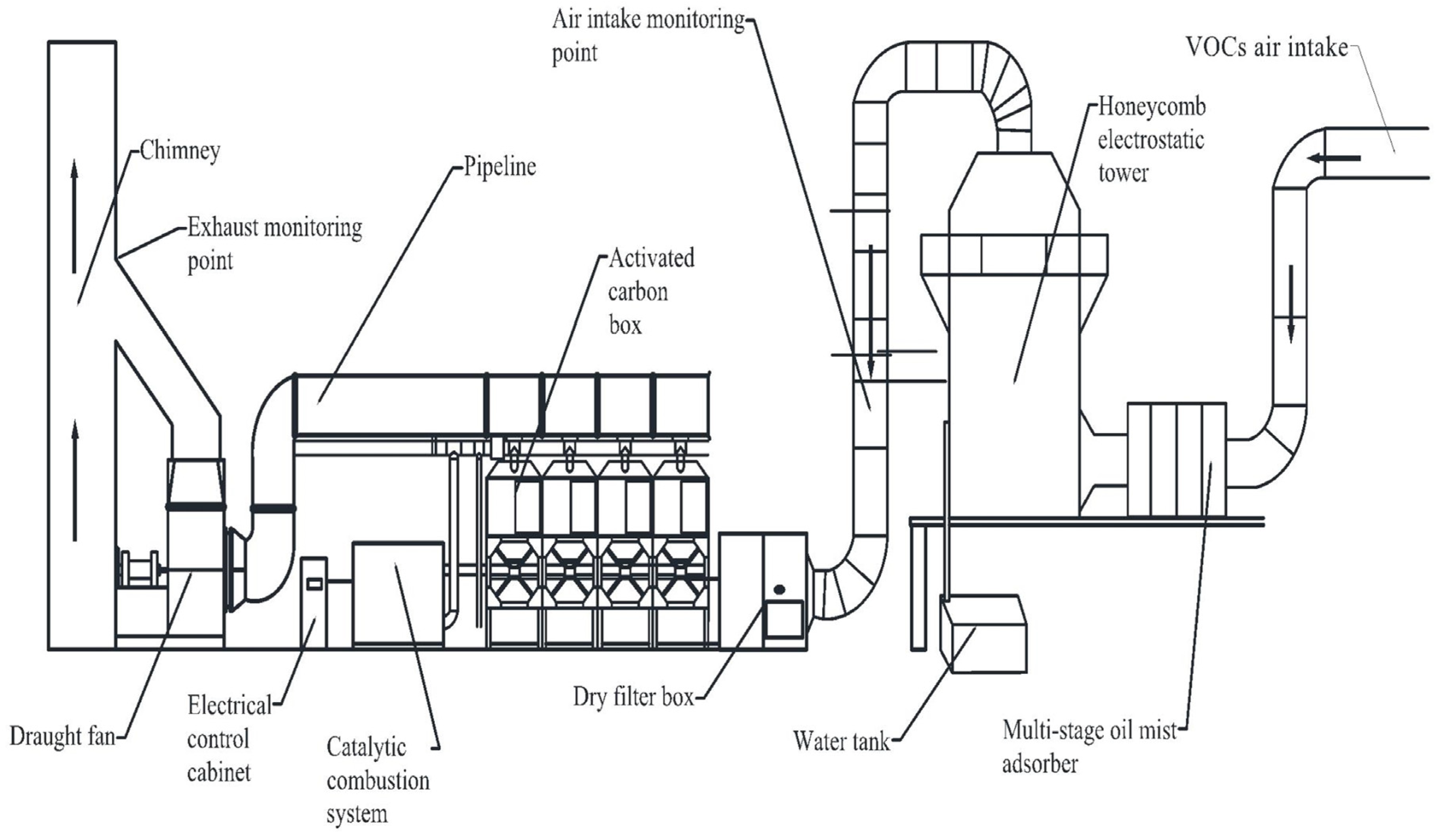
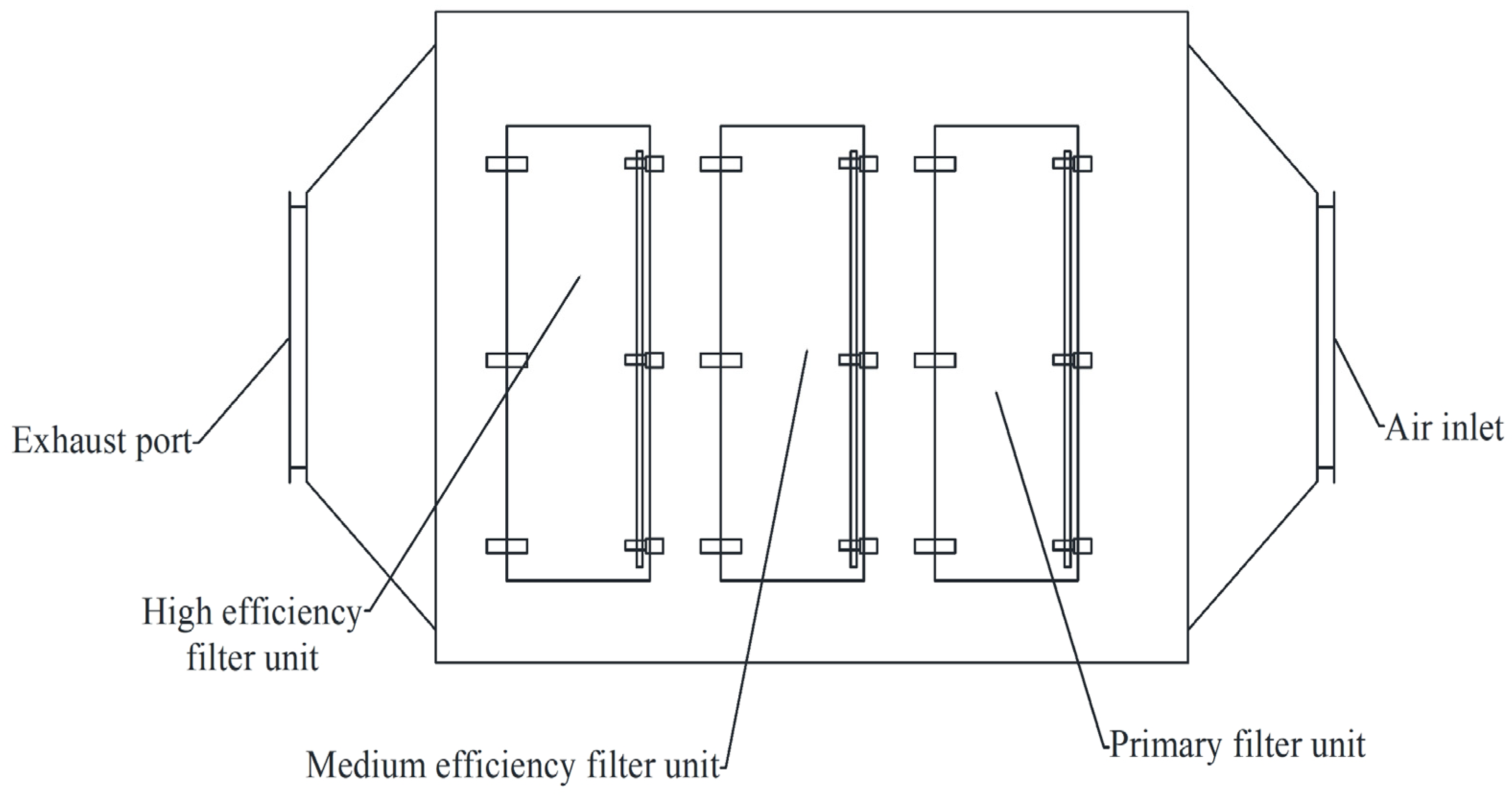
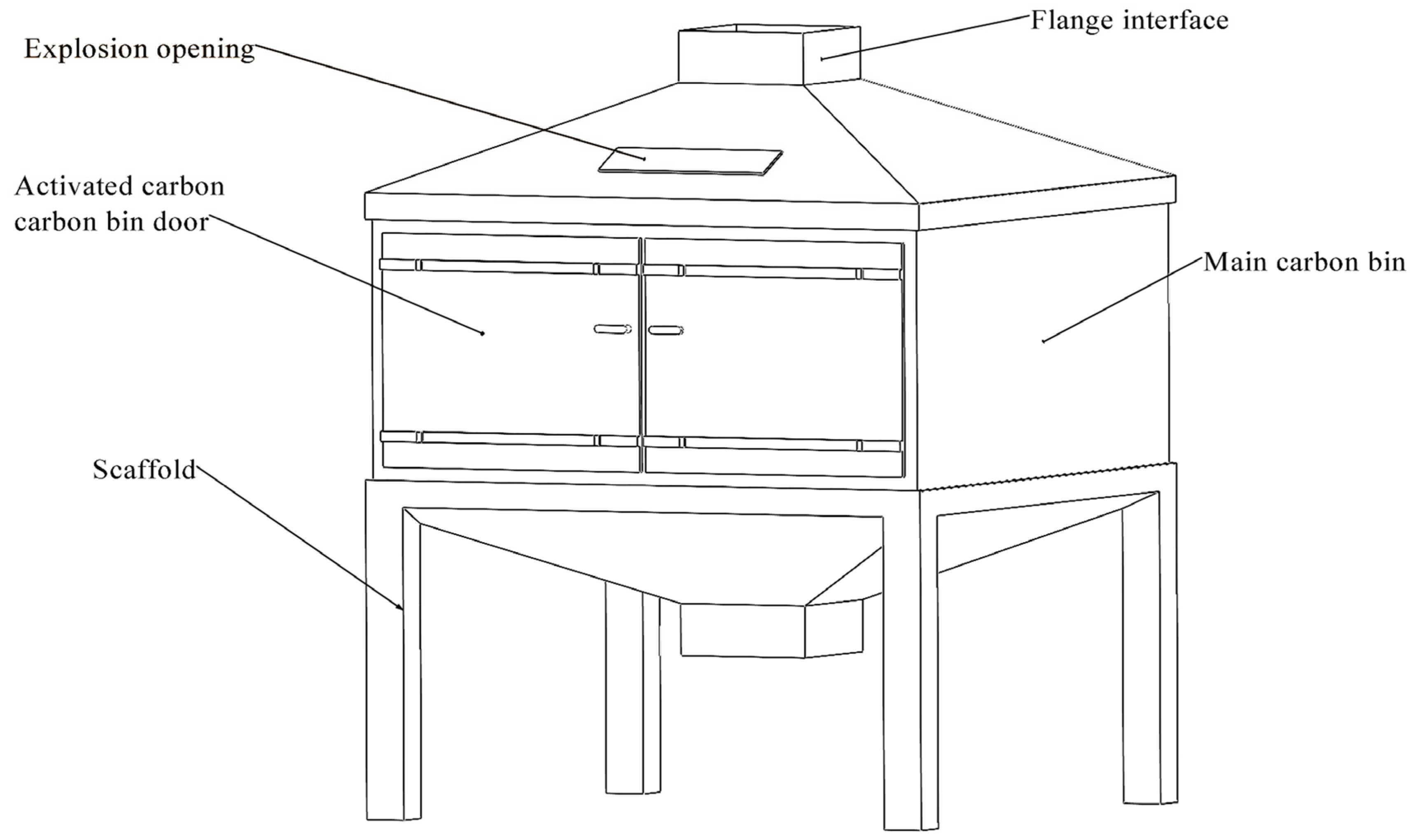


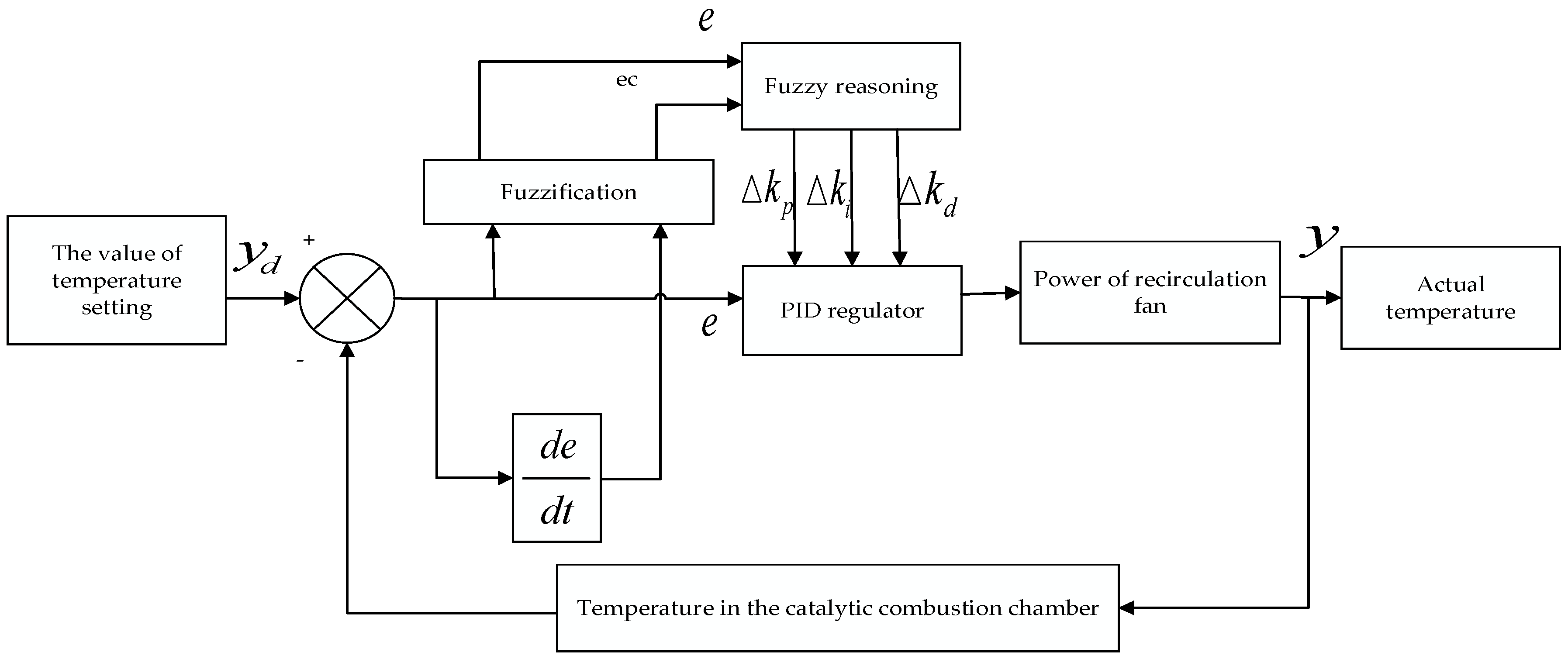


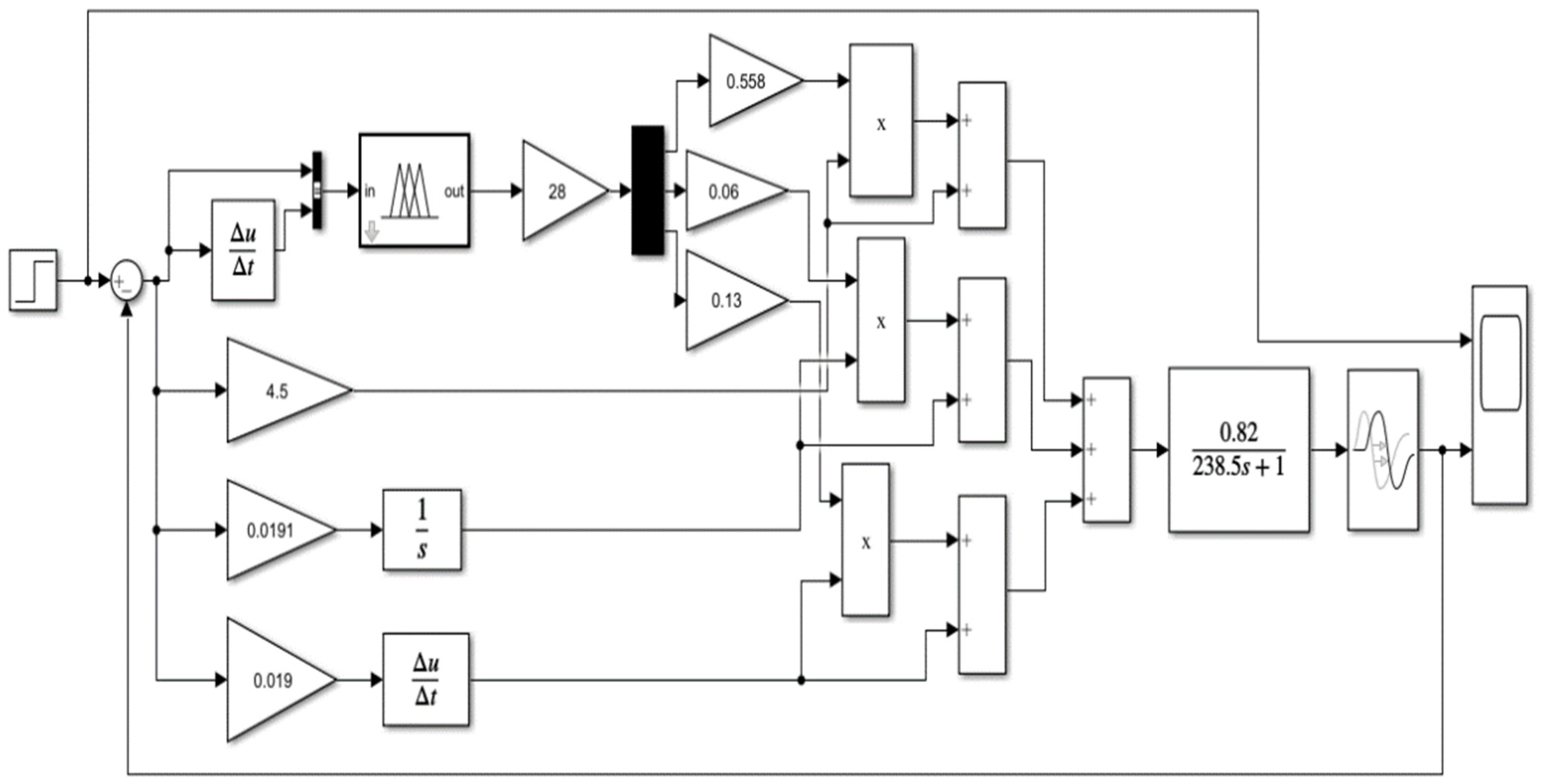

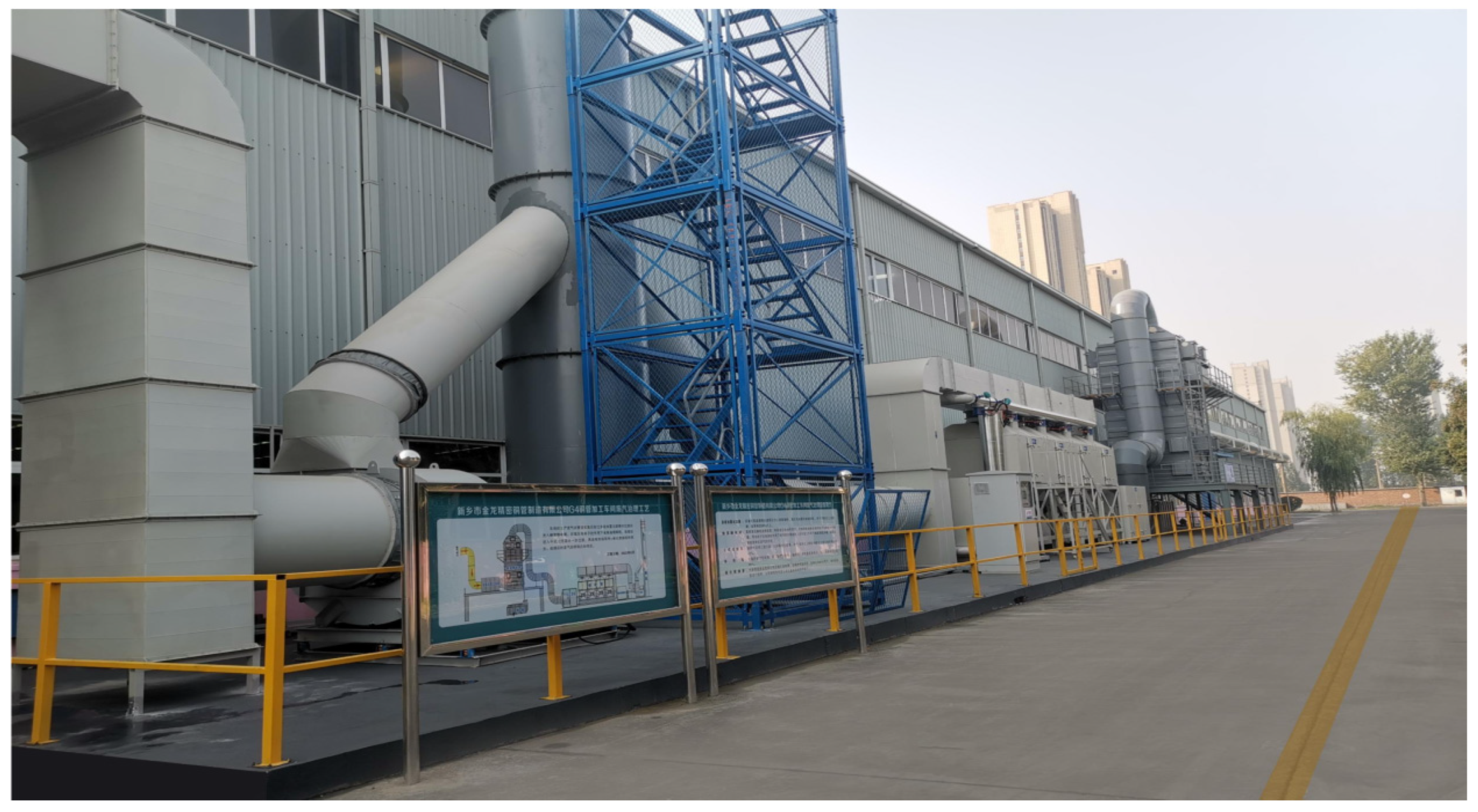
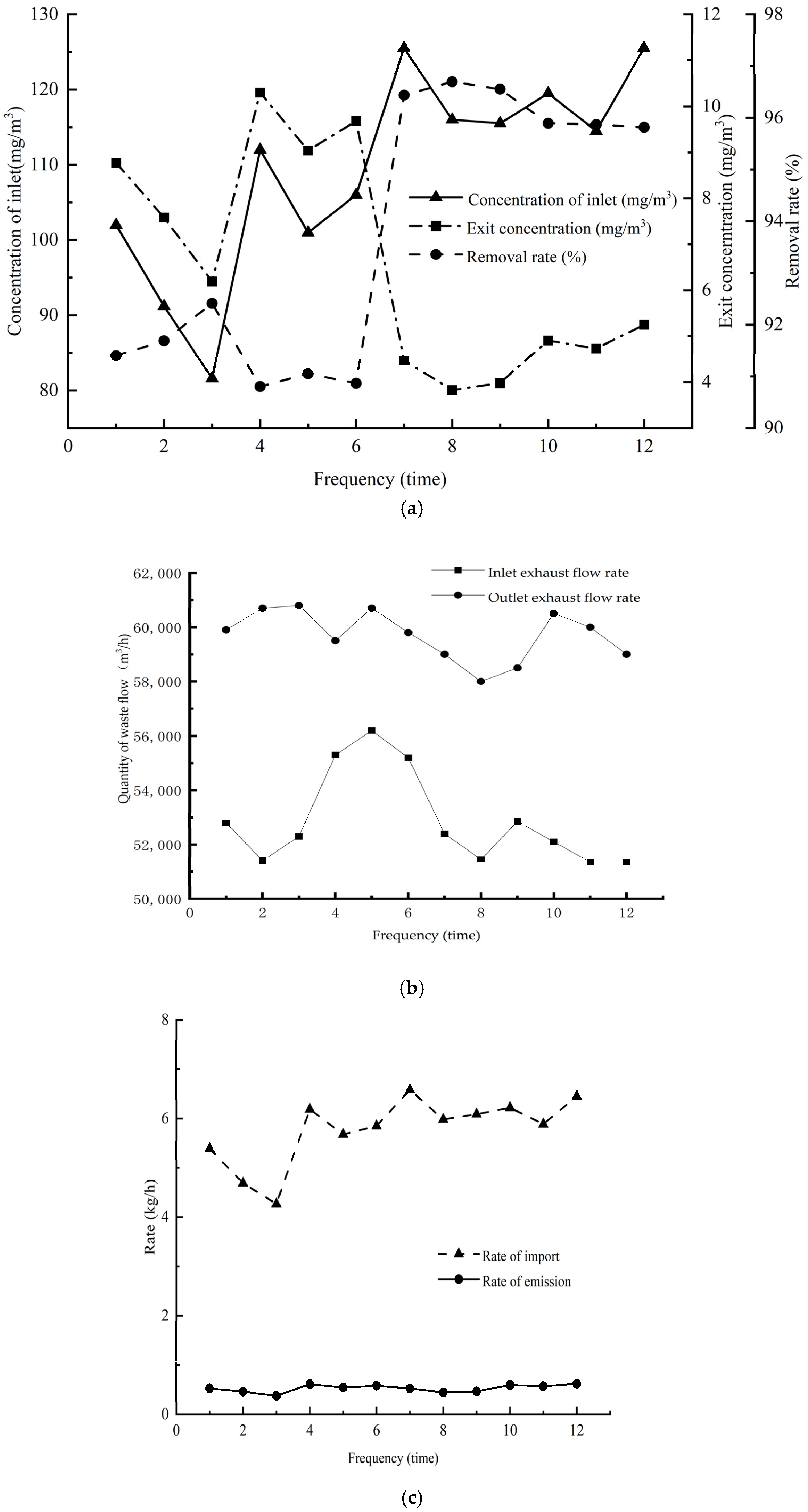
| Designation Item | Parameter | Units |
|---|---|---|
| High-voltage generator maximum power | 20 | kW |
| Honeycomb tube size | Φ159 × 4000 | mm |
| Number of honeycomb tubes in the power plant | 280 | pcs |
| Designation Item | Parameter | Units |
|---|---|---|
| G4 initial filter resistance | <85 | Pa |
| F7 medium filter resistance | <100 | Pa |
| F9 high-efficiency tilter resistance | <130 | Pa |
| Equipment wall thickness | 2 | mm |
| Designation Item | Parameter | Units |
|---|---|---|
| Air volume | 20,000 | m3·h−1 |
| Activated-carbon box size (single) | 2000 × 2000 × 2600 | mm |
| Single activated-carbon fiber filling amount | 150 | kg |
| Section | Designation Item | Parameter | Units |
|---|---|---|---|
| Heat exchange unit | Material and thickness | Q235A cold-rolling sheet steel (t = 2.0) | mm |
| Heat transfer area | 25 | m2 | |
| Number of heat-exchanger tubes | 420 | pcs | |
| Electric heating unit | Cabinet | 600 × 800 × 690 | mm |
| Power | 72 | kW | |
| Amount | 36 | pcs | |
| Other | Boundary dimension | 1500 × 900 × 1500 | mm |
| Outline border | Q235 sheet steel (t = 3) | mm | |
| Faceplate | Q235 sheet steel (t = 1.5) | mm |
| ec | e | ||||||
|---|---|---|---|---|---|---|---|
| NB | NM | NS | ZO | PS | PM | PB | |
| NB | PB/NB/PS | PB/NB/NS | PM/NM/NB | PM/NM/NB | PS/NS/NB | ZO/ZO/NM | ZO/ZO/PS |
| NM | PB/NB/PS | PB/NB/NS | PM/NM/NB | PS/NS/NM | PS/NS/NM | ZO/ZO/NS | NS/ZO/ZO |
| NS | PM/NB/ZO | PM/NM/NS | PM/NS/NM | PS/NS/NM | ZO/ZO/NS | NS/PS/NS | NS/PS/ZO |
| ZO | PM/NM/ZO | PM/NM/NS | PS/NS/NS | ZO/ZO/NS | NS/PS/NS | NM/PM/NS | NM/PM/ZO |
| PS | PS/NM/ZO | PS/NS/ZO | ZO/ZO/ZO | NS/PS/ZO | NS/PS/ZO | NM/PM/ZO | NM/PB/ZO |
| PM | PS/ZO/PB | ZO/ZO/NS | NS/PS/PS | NM/PS/PS | NM/PB/PS | NM/PB/PS | NB/PB/PB |
| PB | ZO/ZO/PB | NS/ZO/PM | NS/PS/PM | NM/PM/PM | NM/PB/PM | NB/PB/PB | NB/PB/PB |
| Numerical Order | Time (s) | Temperature (°C) | Numerical Order | Time (s) | Temperature (°C) |
|---|---|---|---|---|---|
| 1 | 0 | 5 | 9 | 960 | 183.30 |
| 2 | 120 | 27.53 | 10 | 1080 | 205.28 |
| 3 | 240 | 49.99 | 11 | 1200 | 227.18 |
| 4 | 360 | 72.38 | 12 | 1320 | 249.02 |
| 5 | 480 | 94.71 | 13 | 1440 | 270.79 |
| 6 | 600 | 116.96 | 14 | 1560 | 292.49 |
| 7 | 720 | 139.14 | 15 | 1680 | 314.13 |
| 8 | 840 | 161.26 | 16 | 1800 | 335.69 |
| Designation Item | Parameter | Annual Operating Expenses (CNY) | Comment |
|---|---|---|---|
| Cost of replacement of filter cotton | 40 m2 | 9600 | Replace every 30 days, 12 times per year, the unit price is 20 CNY/m2 |
| Electricity charge of system fan | 40 kW | 96,000 | Working hours are 10 h/day, 300 days/year |
| Desorption fan | 2.5 kW | 2064 | Working hours are 6 h/day, 172 times/year |
| Cost of replacement of activated carbon | 4.6 m3 | 19,008 | 9600 CNY/m3 to replace once/3 years |
| Catalytic bed | 72 kW | 16,842.2 | The working time is 4 h/time, 43 times/box/year 4 boxes |
| Catalyst | 0.15 m3 | 9450 | 210,000 CNY/m3 to replace once/3 years |
| Total annual cost | 152,964.2 |
| Technical Name | Governance Efficiency Range | Governance Efficiency Average | Number of Governance Components |
|---|---|---|---|
| Activated-carbon adsorption | −182~86% | 31% | 33 |
| Direct combustion | 85% | 85% | 9 |
| Catalytic combustion | 50~93% | 78% | 53 |
| UV photolysis purification | 34~53% | 44% | 18 |
| Activated-carbon adsorption + catalytic combustion | 85~97% | 90% | 44 |
| Low-temperature plasma + activated carbon | 27~81% | 60% | 29 |
| UV light purification + activated-carbon adsorption | −24~76% | 38% | 33 |
| UV light purification + solvent adsorption | 25~87% | 63% | 6 |
| Technical Name | Applicable Concentration (mg·h−1) | Core Equipment | Merit and Demerit |
|---|---|---|---|
| Activated-carbon adsorption | 2000–10,000 | Adsorption bed | The adsorption range is wide, and the treatment degree is controllable. It is difficult to regenerate and easy to produce secondary pollution |
| Direct combustion | 3000–1/4LEL | Incinerator | High-efficiency, simple maintenance; the processing temperature is high, the fuel cost is high, and the equipment cost is high |
| Catalytic combustion | 1000–1/4LEL | Catalytic combustor | Wide application range, high purification efficiency, no secondary pollution; the catalyst is toxic and needs pretreatment |
| UV photolysis purification | <500 | Photodissociation catalytic reactor | Chemicals are not required, but the reaction rate is slow |
| Low-temperature plasma | <500 | Plasma reactor | Requires high-pressure equipment, covers a large area, but the reaction rate is faster |
| Low-temperature plasma–UV light purification | 20–1000 | Plasma reactor, photodissociation catalytic reactor | Low energy consumption, fewer by-products, fast reaction rate; the mechanism is complex and needs further study |
| UV light purification + activated-carbon adsorption | 200–2000 | Adsorption bed, photodissociation catalytic reactor | Small footprint, mild reaction conditions, low energy consumption, high safety; it is greatly affected by gas flow |
| Activated-carbon adsorption + catalytic combustion | 300–1000 | Adsorption bed, catalytic combustor | Wide range of application, good economic benefits, no secondary pollution, energy saving, and environmental protection; the process conditions are strict, and the safety is limited |
Disclaimer/Publisher’s Note: The statements, opinions and data contained in all publications are solely those of the individual author(s) and contributor(s) and not of MDPI and/or the editor(s). MDPI and/or the editor(s) disclaim responsibility for any injury to people or property resulting from any ideas, methods, instructions or products referred to in the content. |
© 2024 by the authors. Licensee MDPI, Basel, Switzerland. This article is an open access article distributed under the terms and conditions of the Creative Commons Attribution (CC BY) license (https://creativecommons.org/licenses/by/4.0/).
Share and Cite
Fu, C.; He, W.; Wang, Q.; Li, Y.; Yang, H.; Li, H.; Chen, T.; Zhang, Y.; Yu, M.; Wang, Y. Design of Oil Mist and Volatile-Organic-Compound Treatment Equipment in the Manufacturing Plant. Processes 2024, 12, 2050. https://doi.org/10.3390/pr12092050
Fu C, He W, Wang Q, Li Y, Yang H, Li H, Chen T, Zhang Y, Yu M, Wang Y. Design of Oil Mist and Volatile-Organic-Compound Treatment Equipment in the Manufacturing Plant. Processes. 2024; 12(9):2050. https://doi.org/10.3390/pr12092050
Chicago/Turabian StyleFu, Chengguo, Weiwei He, Qianfen Wang, Yuhao Li, Hui Yang, Haibo Li, Ting Chen, Yaqi Zhang, Ming Yu, and Yuguang Wang. 2024. "Design of Oil Mist and Volatile-Organic-Compound Treatment Equipment in the Manufacturing Plant" Processes 12, no. 9: 2050. https://doi.org/10.3390/pr12092050
APA StyleFu, C., He, W., Wang, Q., Li, Y., Yang, H., Li, H., Chen, T., Zhang, Y., Yu, M., & Wang, Y. (2024). Design of Oil Mist and Volatile-Organic-Compound Treatment Equipment in the Manufacturing Plant. Processes, 12(9), 2050. https://doi.org/10.3390/pr12092050






